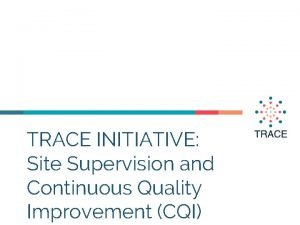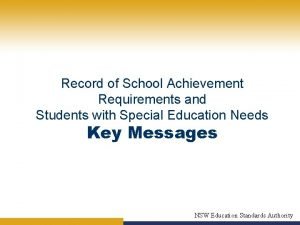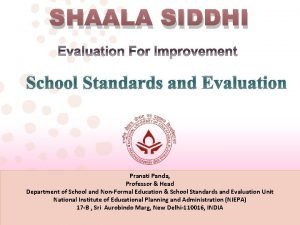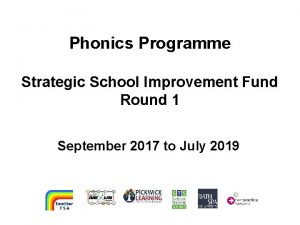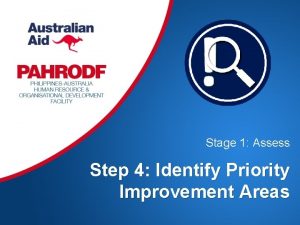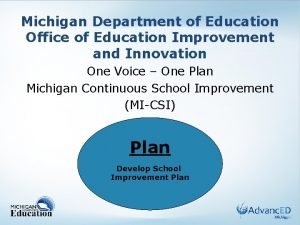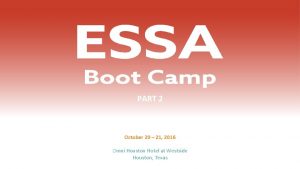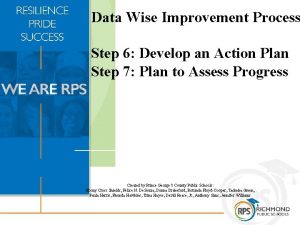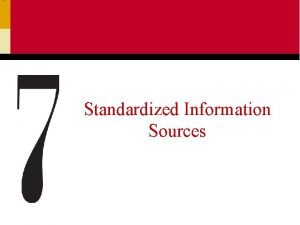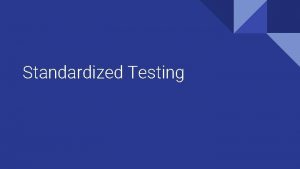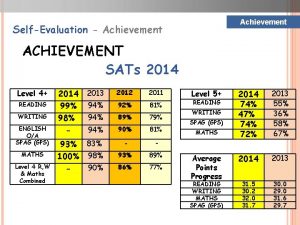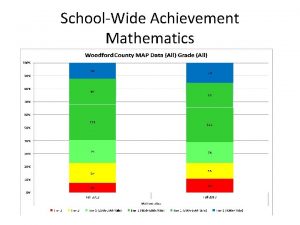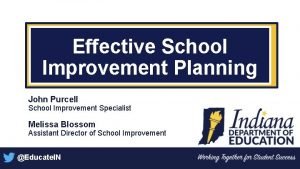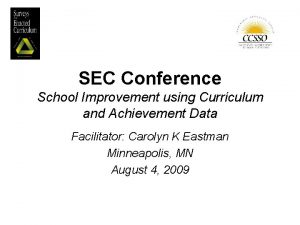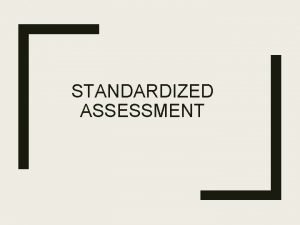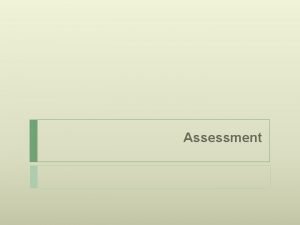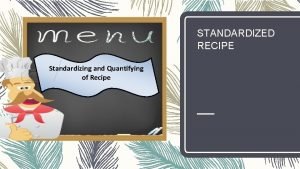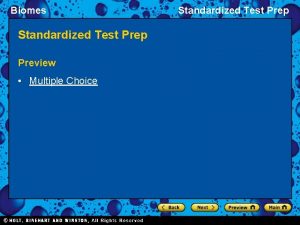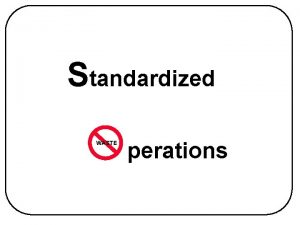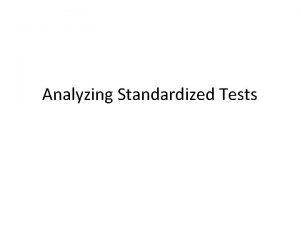Using Standardized Achievement Data for School Improvement Planning

















- Slides: 17

Using Standardized Achievement Data for School Improvement Planning Using to help identify strengths and weaknesses

Standardized Tests �Summative tests �Elaborate process of item-writing and items testing before the test is finalized �Are the items clear and unambiguous? Is there only one correct answer? Is the item too difficult for the grade level? �Assess their validity and reliability �Validity – the test measures what it is intended to measure �Reliability – the test is accurate-the test is consistent each time it is administered and each time it is used.

Two types of Standardized Test Data �Criterion-referenced test (CRT) � Mastery of skills or criteria � Testing the performance of an individual � Examples of CRT: End of level test �Norm-referenced test (NRT) � Measured against the performance of others who take the same test � Examples of NRT: SAT, ITBS, IQ

Analyzing CRT Results Open you book to page 58 -59. Page 58 - Reading Objective 2 Page 58 - Science Objective 18 Page 59 - Vocab Objective 37

How would you use this data to improve the school?

Analyzing Norm and Criterion Data

Understanding Standardized Data �National Stanines �Normal Curve Equivalent (NCE) �Scale Score �National Percentile �Quartiles p. 66 -67 �Achievement Levels � Level I, III, IV

Stanine Score

Normal Curve Equivalent

Scale Score Conversion of the student’s raw score into a common score. This allows educators to measure the growth of the students from year to year.


National Percentile If a student scores at the 90 th percentile then it means they scored higher than 89 percent of the students who took the test.

Achievement Levels

Disaggregated Data Subgroups

Limitations of Standardized Tests �Test items are narrow. What should be covered on a math test? �Factual information, problem-solving ability creatively in approaching problems, and deep understanding �Not aligned to the curriculum. Who’s standards are being represented? �One-shot moment in time usually at the end of the school year.

� 8 th GRADE FINAL EXAM Grammar (Time, one hour) 1. Give nine rules for the use of Capital Letters. 2. Name the Parts of Speech and define those that have no Modifications. 3. Define Verse, Stanza and Paragraph. 4. What are the Principal Parts of a verb. Give Principal Parts of. lie, lay and run 5. Define Case, Illustrate each Case. 6. What is Punctuation? Give rules for principal marks of Punctuation. 7. Write a composition of about 150 words and show therein that you understand the practical use of the rules of grammar. Arithmetic (Time, 1. 25 hours) 1. Name and define the Fundamental Rules of Arithmetic. 2. A wagon box is 2 ft deep, 10 feet long and 3 ft. wide. How many bushels of wheat will it hold? 3. If a load of wheat weighs 3942 lbs. , what is it worth at 50 cts/bushel, deducting 1050 lbs. for tare? 4. District No. 33 has a valuation of $35, 000. What is the necessary levy to carry on a school seven months at $50 per month, and have $104 for incidentals? 5. Find cost of 6720 lbs. coal at $6. 00 per ton. 6. Find the interest of $512. 60 for 8 months and 18 days at 7 percent. 7. What is the cost of 40 boards 12 inches wide and 16 ft. long at $20 per meter? 8 Find bank discount on $300 for! 90 days (no grace) at 10 percent. 9. What is the cost of a square farm at $15 per acre, the distance around which is 640 rods? 10. Write a Bank Check, a Promissory Note, and a Receipt. U. S. History (Time, 45 minutes) 1. Give the epochs into which U. S. History is divided. 2. Give an account of the discovery of Americaby Columbus. 3. Relate the causes and results of the Revolutionary War. 4. Show the territorial growth of the United States. 5. Tell what you can of the history of Kansas. 6. Describe three of the most prominent battles of the Rebellion. 7. Who were the following: Morse, Whitney, Fulton, Bell, Lincoln, Penn, and Howe? 8. Name events connected with the following dates: 1607, 1620, 1800, 1849, 1865. Orthography (Time, one hour) 1. What is meant by the following: Alphabet, phonetic, orthography, etymology, syllabication? 2. What are elementary sounds? How classified? 3. What are the following, and give examples of each: Trigraph, sub vocals, diphthong, cognate letters, linguals? 4. Give four substitutes for caret 'u! '. 5. Give two rules for spelling words with final 'e. ' Name two exceptions under each rule. 6. Give two uses of silent letters in spelling. Illustrate each. 7. Define the following prefixes and use in connection with a word: bi, dis, mis, pre, semi, post, non, inter, mono, sup 8. Mark diacritically and divide into syllables the following, and name the sign that indicates the sound: card, ball, mercy, sir, odd, cell, rise, blood, fare, last. 9. Use the following correctly in sentences: cite, sight, fane, fain, feign, vane, vain, vein, raze, raise, rays. 10. Write 10 words frequently mispronounced and indicate pronunciation by use of diacritical marks and by syllabication. Geography (Time, one hour) 1. What is climate? Upon what does climate depend? 2. How do you account for the extremes of climate in Kansas? 3. Of what use are rivers? Of what use is the ocean? 4. Describe the mountains of North America. 5. Name and describe the following: Monrovia, Odessa, Denver, Manitoba, Hecla, Yukon, St. Helena, Juan Fernandez, Aspinwall & Orinoco. 6. Name and locate the principal trade centers of the U. S. 7. Name all the republics of Europeand give the capital of each. 8. Why is the Atlantic Coastcolder than the Pacific in the same latitude? 9. Describe the process by which the water of the ocean returns to the sources of rivers. 10. Describe the movements of the earth. Give the inclination of the earth. �

Last Words:
 Objectives of a standard recipe
Objectives of a standard recipe Continuous quality improvement program planning worksheet
Continuous quality improvement program planning worksheet Record of school achievement
Record of school achievement Shaala siddhi school improvement plan example
Shaala siddhi school improvement plan example Swot analysis of school improvement plan
Swot analysis of school improvement plan Strategic school improvement fund round 3
Strategic school improvement fund round 3 Priority improvement areas template
Priority improvement areas template School improvement plan michigan
School improvement plan michigan Strategic school improvement fund round 3
Strategic school improvement fund round 3 School improvement plan
School improvement plan Fast direct peace with christ
Fast direct peace with christ Ambition school leadership
Ambition school leadership Data wise improvement process
Data wise improvement process Data driven quality
Data driven quality Fspos
Fspos Typiska drag för en novell
Typiska drag för en novell Tack för att ni lyssnade bild
Tack för att ni lyssnade bild Returpilarna
Returpilarna

